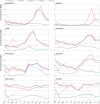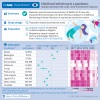Indirect effects of the covid-19 pandemic on childhood infection in England: population based observational study
- PMID: 35022215
- PMCID: PMC8753487
- DOI: 10.1136/bmj-2021-067519
Indirect effects of the covid-19 pandemic on childhood infection in England: population based observational study
Abstract
Objective: To assess the impact of the covid-19 pandemic on hospital admission rates and mortality outcomes for childhood respiratory infections, severe invasive infections, and vaccine preventable disease in England.
Design: Population based observational study of 19 common childhood respiratory, severe invasive, and vaccine preventable infections, comparing hospital admission rates and mortality outcomes before and after the onset of the pandemic in England.
Setting: Hospital admission data from every NHS hospital in England from 1 March 2017 to 30 June 2021 with record linkage to national mortality data.
Population: Children aged 0-14 years admitted to an NHS hospital with a selected childhood infection from 1 March 2017 to 30 June 2021.
Main outcome measures: For each infection, numbers of hospital admissions every month from 1 March 2017 to 30 June 2021, percentage changes in the number of hospital admissions before and after 1 March 2020, and adjusted odds ratios to compare 60 day case fatality outcomes before and after 1 March 2020.
Results: After 1 March 2020, substantial and sustained reductions in hospital admissions were found for all but one of the 19 infective conditions studied. Among the respiratory infections, the greatest percentage reductions were for influenza (mean annual number admitted between 1 March 2017 and 29 February 2020 was 5379 and number of children admitted from 1 March 2020 to 28 February 2021 was 304, 94% reduction, 95% confidence interval 89% to 97%), and bronchiolitis (from 51 655 to 9423, 82% reduction, 95% confidence interval 79% to 84%). Among the severe invasive infections, the greatest reduction was for meningitis (50% reduction, 47% to 52%). For the vaccine preventable infections, reductions ranged from 53% (32% to 68%) for mumps to 90% (80% to 95%) for measles. Reductions were seen across all demographic subgroups and in children with underlying comorbidities. Corresponding decreases were also found for the absolute numbers of 60 day case fatalities, although the proportion of children admitted for pneumonia who died within 60 days increased (age-sex adjusted odds ratio 1.71, 95% confidence interval 1.43 to 2.05). More recent data indicate that some respiratory infections increased to higher levels than usual after May 2021.
Conclusions: During the covid-19 pandemic, a range of behavioural changes (adoption of non-pharmacological interventions) and societal strategies (school closures, lockdowns, and restricted travel) were used to reduce transmission of SARS-CoV-2, which also reduced admissions for common and severe childhood infections. Continued monitoring of these infections is required as social restrictions evolve.
© Author(s) (or their employer(s)) 2019. Re-use permitted under CC BY. No commercial re-use. See rights and permissions. Published by BMJ.
Conflict of interest statement
Competing interests: All authors have completed the ICMJE uniform disclosure form at www.icmje.org/disclosure-of-interest/ and declare: support from Office for Health Improvement and Disparities, Health Data Research UK, and the National Institute for Health Research Oxford Biomedical Research Centre for the submitted work; grants from the National Institute for Health Research, Bill and Melinda Gates Foundation, Wellcome Trust, and Astra Zeneca in the previous three years; no other relationships or activities that could appear to have influenced the submitted work.
Figures





References
-
- Dong Y, Mo X, Hu Y, et al. Epidemiological characteristics of 2143 pediatric patients with 2019 coronavirus disease in China. J Emerg Med 2020;58:712-3 10.1016/j.jemermed.2020.04.006. - DOI
Publication types
MeSH terms
LinkOut - more resources
Full Text Sources
Medical
Miscellaneous
